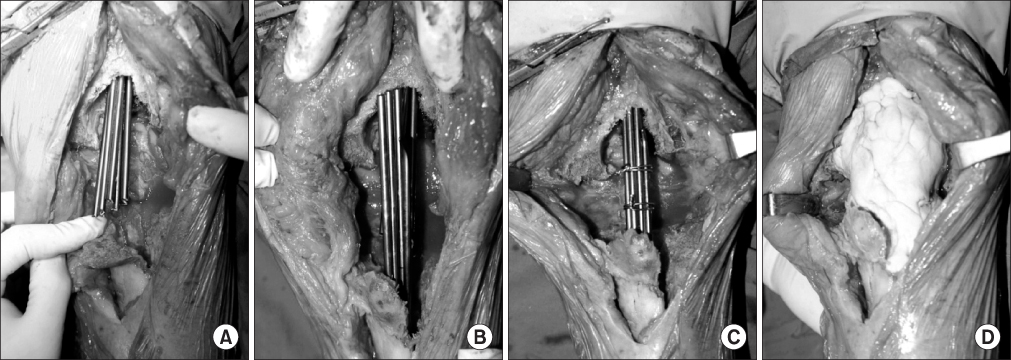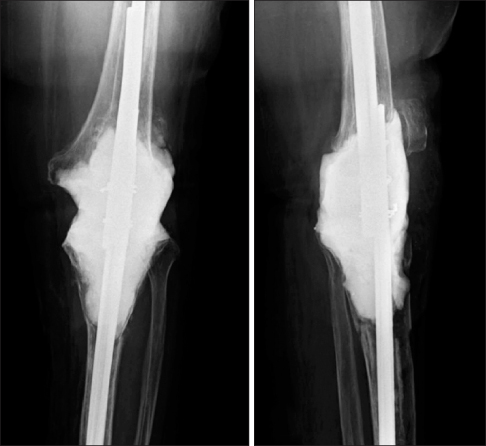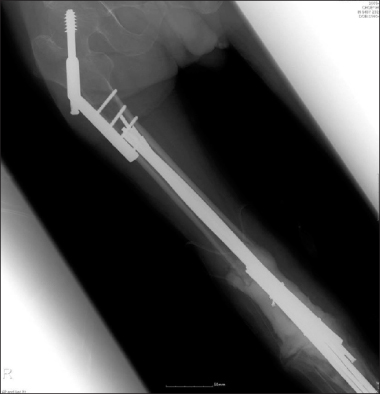J Korean Orthop Assoc.
2014 Feb;49(1):79-84. 10.4055/jkoa.2014.49.1.79.
Artificial Fusion of Infected Total Knee Arthroplasty Using a Flexible Intramedullary Rod Bundle and an Antibiotic-Loaded Cement Spacer
- Affiliations
-
- 1Department of Orthopaedic Surgery, Korea University Anam Hospital, Seoul, Korea. oshan@korea.ac.kr
- 2Department of Orthopaedic Surgery, Inje University Ilsan Paik Hospital, Goyang, Korea.
- 3Department of Orthopaedic Surgery, VHS Medical Center, Seoul, Korea.
- KMID: 2185263
- DOI: http://doi.org/10.4055/jkoa.2014.49.1.79
Abstract
- Multiple total knee arthroplasty (TKA) failure resulting from a recurrent infection is a challenging problem. Knee arthrodesis is one treatment option that normally involves the application of an external fixator, plate fixation, and intramedullary nailing. However, these approaches are not always successful, and a reinfection is a risk, particularly in older, medically compromised patients. This paper reports a new arthrodesis technique that uses a bundle of flexible intramedullary rods and an antibiotic-loaded cement spacer. This technique was used in two cases of multiple TKA failure that resulted from a recurrent infection. The procedure was successful in both cases with no evidence of rod or cement failure. Two advantages of this procedure are infection eradication and mechanical strength. However, this procedure should only be used for medically compromised elderly patients at high risk of rerevision TKA failure resulting from persistent periprosthetic infection because rod fracture or loosening can occur with time.
MeSH Terms
Figure
Reference
-
1. Hart WJ, Jones RS. Two-stage revision of infected total knee replacements using articulating cement spacers and short-term antibiotic therapy. J Bone Joint Surg Br. 2006; 88:1011–1015.2. Senior CJ, da Assunção RE, Barlow IW. Knee arthrodesis for limb salvage with an intramedullary coupled nail. Arch Orthop Trauma Surg. 2008; 128:683–687.3. Klinger HM, Spahn G, Schultz W, Baums MH. Arthrodesis of the knee after failed infected total knee arthroplasty. Knee Surg Sports Traumatol Arthrosc. 2006; 14:447–453.4. Campanacci M, Costa P. Total resection of distal femur or proximal tibia for bone tumours. Autogenous bone grafts and arthrodesis in twenty-six cases. J Bone Joint Surg Br. 1979; 61-B:455–463.5. Sundgren K. Cemented modular intramedullary nail in failed knee arthroplasty--a report of 2 cases. Acta Orthop Scand. 1999; 70:305–307.
Article6. De Vil J, Almqvist KF, Vanheeren P, Boone B, Verdonk R. Knee arthrodesis with an intramedullary nail: a retrospective study. Knee Surg Sports Traumatol Arthrosc. 2008; 16:645–650.
Article7. Persson BM, Rydholm A. Artificial fusion of the knee joint with intramedullary nail and acrylic cementation following radical excision for tumor. Arch Orthop Trauma Surg. 1984; 102:260–263.
Article8. Capanna R, Biagini R, Ruggieri P, Bettelli G, Casadei R, Campanacci M. Temporary resection-arthrodesis of the knee using an intramedullary rod and bone cement. Int Orthop. 1989; 13:253–258.
Article9. Hsieh PH, Tai CL, Lee PC, Chang YH. Liquid gentamicin and vancomycin in bone cement: a potentially more cost-effective regimen. J Arthroplasty. 2009; 24:125–130.
Article10. Ha CW. A technique for intraoperative construction of antibiotic spacers. Clin Orthop Relat Res. 2006; 445:204–209.
- Full Text Links
- Actions
-
Cited
- CITED
-
- Close
- Share
- Similar articles
-
- Two-Stage Reimplantation of Infected Total Knee Arthroplasty with Antibiotic-Loaded Bone Cement Spacer: Comparison of the Types of Antibiotic-Loaded Cement Spacer
- The Modified Static Spacers Using Antibiotic-Impregnated Cement Rod in Two-Stage Revision for Infected Total Knee Arthroplasty
- Staged Reimplantation Using Cement Spacer Containing Antibiotics in Infected Total Knee Arthroplasty
- Short-term Results of Two-stage Reimplantation Using Antibiotic-loaded Articulating Cement Spacer in Infected Total Knee Arthroplasty
- Two-Stage Revision Using a Modified Articulating Spacer in Infected Total Knee Arthroplasty




